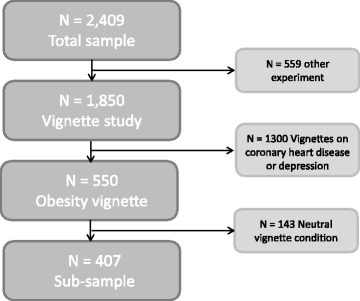Changing attitudes towards obesity - results from a survey experiment
- PMID: 28464915
- PMCID: PMC5414181
- DOI: 10.1186/s12889-017-4275-y
Changing attitudes towards obesity - results from a survey experiment
Abstract
Background: This experimental study in a population-based sample aimed to compare attitudes towards obesity following three different causal explanations for obesity (individual behavior, environmental factors, genetic factors).
Methods: The data were derived from an online representative sample. A random subsample of n = 407 participants was included. Two independent variables were investigated: cause of obesity as described in the vignette and cause of obesity as perceived by the participant regardless of vignette. Quality features of the vignettes (accuracy and bias of the vignette) were introduced as moderators to regression models. Three stigma-related outcomes (negative attitudes, blame and social distance) served as dependent variables.
Results: Inaccuracy and bias was ascribed to the social environmental and genetic vignettes more often than to the individual cause vignette. Overall, participants preferred individual causes (72.6%). While personal beliefs did not differ between the genetic and environmental cause conditions (Chi2 = 4.36, p = 0.113), both were different from the distribution seen in the individual cause vignette. Negative attitudes as well as blame were associated with the belief that individuals are responsible for obesity (b = 0.374, p = 0.003; 0.597, p < 0.001), but were not associated with vignette-manipulated causal explanation. The vignette presenting individual responsibility was associated with lower levels of social distance (b = -0.183, p = 0.043). After including perceived inaccuracy and bias as moderators, the individual responsibility vignette was associated with higher levels of blame (emphasis: b = 0.980, p = 0.010; bias: b = 0.778, p = 0.001) and the effect on social distance vanished.
Conclusions: This study shows that media and public health campaigns may solidify beliefs that obesity is due to individual causes and consequently increase stigma when presenting individual behavior as a cause of obesity. Public health messages that emphasize the role of social environmental or genetic causes may be ineffective because of entrenched beliefs.
Keywords: Attitudes; Obesity; Population-based study; Public health; Stigmatization; Vignette study.
Similar articles
-
Different biogenetic causal explanations and attitudes towards persons with major depression, schizophrenia and alcohol dependence: is the concept of a chemical imbalance beneficial?J Affect Disord. 2014 Oct;168:224-8. doi: 10.1016/j.jad.2014.06.013. Epub 2014 Jun 16. J Affect Disord. 2014. PMID: 25064807
-
Obese children, adults and senior citizens in the eyes of the general public: results of a representative study on stigma and causation of obesity.PLoS One. 2012;7(10):e46924. doi: 10.1371/journal.pone.0046924. Epub 2012 Oct 12. PLoS One. 2012. PMID: 23071664 Free PMC article.
-
Causal beliefs of the public and social acceptance of persons with mental illness: a comparative analysis of schizophrenia, depression and alcohol dependence.Psychol Med. 2014 Jan;44(2):303-14. doi: 10.1017/S003329171300072X. Epub 2013 Apr 11. Psychol Med. 2014. PMID: 23574735 Clinical Trial.
-
Obesity Stigma: Causes, Consequences, and Potential Solutions.Curr Obes Rep. 2023 Mar;12(1):10-23. doi: 10.1007/s13679-023-00495-3. Epub 2023 Feb 14. Curr Obes Rep. 2023. PMID: 36781624 Free PMC article. Review.
-
A Narrative Review of Physician Perspectives Regarding the Social and Environmental Determinants of Obesity.Curr Diab Rep. 2018 Mar 21;18(5):24. doi: 10.1007/s11892-018-0990-8. Curr Diab Rep. 2018. PMID: 29564581 Review.
Cited by
-
Healthy Life Centre participants' perceptions of living with overweight or obesity and seeking help for a perceived "wrong" lifestyle - a qualitative interview study.BMC Obes. 2018 Dec 6;5:42. doi: 10.1186/s40608-018-0218-0. eCollection 2018. BMC Obes. 2018. PMID: 30546910 Free PMC article.
-
Influence of Body Mass Index and Gender on Stigmatization of Obesity.Obes Surg. 2020 Dec;30(12):4926-4934. doi: 10.1007/s11695-020-04895-5. Epub 2020 Aug 9. Obes Surg. 2020. PMID: 32772227 Free PMC article.
-
Determining Associations Among Health Orientation, Fitness Orientation, and Attitudes Toward Fatness in Physiotherapists and Physiotherapy Students Using Structural Equation Modeling.Physiother Can. 2024 May 8;76(2):220-229. doi: 10.3138/ptc-2022-0038. eCollection 2024 May. Physiother Can. 2024. PMID: 38725602 Free PMC article.
-
Public beliefs about causes of obesity in the USA and in Germany.Int J Public Health. 2019 Nov;64(8):1139-1146. doi: 10.1007/s00038-019-01295-0. Epub 2019 Sep 4. Int J Public Health. 2019. PMID: 31485759
-
Listening to the voices of adolescents for the design of strategies to promote healthy eating: an exploratory study in a Latin American country.Public Health Nutr. 2021 Dec;24(17):5953-5962. doi: 10.1017/S1368980021002548. Epub 2021 Jun 9. Public Health Nutr. 2021. PMID: 34105451 Free PMC article.
References
-
- World Health Organization."Obesity and overweight, Fact Sheet Number 311". 2014. http://www.who.int/mediacentre/factsheets/fs311/en/. Accessed 12–6-2014.
-
- Link BG, Phelan JC. Conceptualizing Stigma. Annu Rev Sociol. 2001;27:363. doi: 10.1146/annurev.soc.27.1.363. - DOI
MeSH terms
LinkOut - more resources
Full Text Sources
Other Literature Sources
Medical
Research Materials


